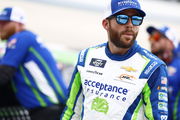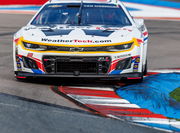
Imago
NASCAR Bristol

Imago
NASCAR Bristol
So the old-school feel at the Bristol Spring Race back in March was only a one-off affair. Saturday’s Bass Pro Shops Night Race broke all misconceptions of the “glory days” returning to Thunder Valley.
Watch What’s Trending Now!
The wider surface introduced by SMI in 2007 was supposed to promote passing on its concrete. But almost two decades later, the changes haven’t been all that impactful in hindsight. After countless experiments failed to bring things back to the ‘bump-and-run’ normalcy of yesteryears, the experts suggest we might have lost the old Bristol for good.
ADVERTISEMENT
SMI’s 2007 changes still raise unanswered questions
When Speedway Motorsports LLC (SMI) completed its acquisition of Bristol Motor Speedway in 1996, short-track racing was experiencing its golden era. Bristol, back then, was a shining beacon of NASCAR’s signature product. Since those days, SMI has invested millions of dollars into the upkeep of the “world’s fastest half-mile”. Increased seating capacity, a giant center-hung digital display screen, the Kulwicki Tower — everything a racetrack could need to survive in the modern era Bristol has built in and around its confines.
However, two changes have been most impactful to the racetrack in recent years. The first one happened in 2007, when SMI widened the racing surface by 3 feet, converting its progressive bankings into a variable banking system. The second began in 2016 when the track started applying traction compound to help restore Bristol’s reputation for single-file, close-contact racing.
Earlier this year, when the tires started falling without regard at the Spring Race, it resulted in a track record for lead changes. Some believed Bristol had finally regained its long-lost potential. But with only 8 lead changes last Saturday, that notion fell flat. All the fallout from Kyle Larson’s total domination has left the collective community with plenty of unanswered questions. A very important one surfaced on the September 23rd episode of AskDBC, when a fan asked the controversial spotter cast: “Is Bristol better with one groove or multiple grooves?”
ADVERTISEMENT
Freddie Kraft, spotter of the #23 team in the Cup Series, answered, “All Bristol! Give me locked on the bottom knocking each other out of the way, but the problem is we can’t do that right now… Like, locked on the bottom, you cannot move the guy… So, you know, if we can ever get back to just run in the bottom where we can rattle each other’s cages a little bit. That’ll be my ideal scenario.” It’s funny Kraft would use that phrase, ‘rattle each other’s cage,’ since it was on this very Bristol where Dale Earnhardt coined it after spinning Terry Labonte to win the Night Race in ’99. That was the ‘old Bristol’ that long-time fans had grown accustomed to over the years.
The nostalgia must’ve made Brett Griffin think about that Bristol, because he followed up on his podcast partner’s thoughts to ask, “But why can’t you tear it up and make it like old Bristol?” Kraft would not leave the question hanging, and swiftly told Griffin, “I mean, you could. I would imagine money would be a major factor…” Wrapping up the dialogue with some much-needed banter, Kraft then mused, “Plus Dale (Earnhardt Jr) drank a lot of beer on Friday night….” But no, Bristol Motor Speedway is not “recouping from that loss,” as Karsyn Elledge mentioned completing the thoughts of the #23 spotter.
ADVERTISEMENT
But what seems to be the problem? Sure, drivers like Denny Hamlin and Joey Logano have actively advocated for a horsepower bump to fix the current state of short-track racing. However, from the looks of things, a few extra factors are affecting NASCAR’s product.
Top Stories
Ross Chastain Labels NASCAR Driver “The Most Punchable Face” to Excuse Himself Over Punchgate Controversy

Commissioner Steve Phelps Quits NASCAR Days After Getting Exposed in Lawsuit Trial

Who Is Steve Phelps? NASCAR Commissioner’s Net Worth, Wife & NASCAR Contract

NASCAR Rumor: Justin Marks’ Trackhouse to Lose $4.5M in Sponsorship After Billionaire Partner’s Exit

Jimmie Johnson Poaches Richard Childress’ Key Ally Ahead of NASCAR 2026 Season

From glory days to a glaring dilemma
For starters, the Next-Gen car and its wider 18′ tires produce a lot of grip on the racetrack. It also features a larger brake package and the limitations in horsepower only increase the drag of this Gen-7 machine. Kyle Busch said it best a few months ago to Matt Weaver of Sportsnaut, “I think we’ve all kind of said that, when the tire got wider, we all knew it was going to produce more grip… We all expected it to be softer so it would wear, and it would wear out and then you would have less grip over the course of a run and have some falloff… But unfortunately, we haven’t seen that.”
ADVERTISEMENT
In fairness, we have seen something like that with Goodyear’s softer ‘Option’ tires this year that made their non-points paying debut in North Wilkesboro. A few weeks ago, the red-lettered radials were back again, for its first points-paying race in Richmond. However, NASCAR and its tire partners have not rolled the tires out regularly. Hence, making inferences based on a couple of appearances would make little sense in the bigger picture.
Another notable outlier seems to be the PJ1 Trackbite compound. Since 2016, this traction-enhancing formula has been visible on the lower groove at Bristol. The primary reason it’s applied to the surface is in hopes of replicating ‘artificial multi-groove racing.’ Strangely, when the concerned officials replaced PJ1 with VP Resin in March, the Bristol Spring Race experienced almost unnatural degradation, with cars barely lasting 40-50 laps on the tires. As soon as NASCAR brought PJ1 back to Thunder Valley, the racing returned to what has been the norm for the last few years.
Minimal lead changes, cars struggling to make passes, the tires running perfectly fine for over 100 laps–it looked like the curse had come back to haunt those battling inside the “Last Great Colosseum.” The track officials even removed all rubber from the top of the track to promote multi-lane racing. Regardless, none of those changes truly turned out as intended. And in the end, the general opinion has since been we might lose another short track date, thanks to all these mysterious circumstances. So will NASCAR make any more experiments to improve their signature racing product? Or will Bristol slowly fade into short-track oblivion as time goes by? The answer will not be simple at all, everything considered.
ADVERTISEMENT
ADVERTISEMENT
ADVERTISEMENT
ADVERTISEMENT

